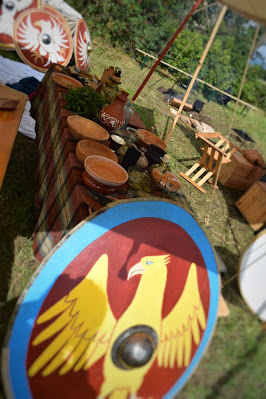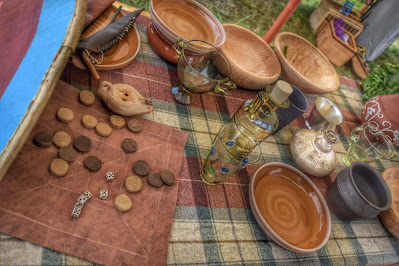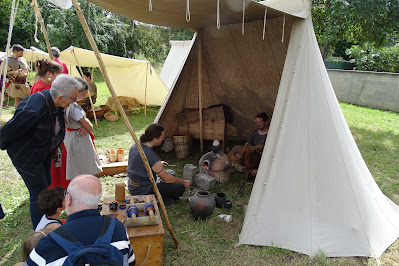 |
TRIBOCI CIVITAS TRIBOCORUM et HERCULIANI IUNIORES |
(English translation is available below)
Un petit billet différent pour évoquer très rapidement la reconstitution historique. J'ai eu le plaisir de participer ce dimanche, avec mon association, à une manifestation culturelle, les Estivales d'Epona, à Horbourg-Wihr, près de Colmar. S'y étaient réunies, cinq associations de reconstitution historique (dont vous trouverez la liste en suivant le lien précédent), sur le thème de la vie gallo-romaine. Il était possible d'y assister à quelques présentations de manœuvres et équipements militaires, mais également des objets de la vie de tous les jours. Des exemples de bijoux, de céramiques, d'ustensiles divers, reconstitués à partir de trouvailles archéologiques ou de représentations antiques, étaient visibles, avec des passionnés d'histoire pour en faire la description et répondre aux questions. De notre côté, nous avions même l'un ou l'autre jeu de société d'époque ! Des présentations d'ateliers de tisserands ou de métallurgie était également visibles mais, malheureusement, une affluence certaine m'a empêché d'aller observer tout ceci. Mais au fond, c'est une bonne chose, puisque ça signifie que je n'étais pas désœuvré !
 |
| Cartographie, TRIBOCI CIVITAS TRIBOCORUM |
Pour ma part, j'ai pu parler de géographie antique, présenter le concept, la pratique et la façon dont elle était envisagée dans l'Antiquité européenne, essentiellement grecque et romaine. Et en profiter pour dissiper certaines idées préconçues, et autres notions fantaisistes telle que la Terre plate. En effet, une tendance durable s'est ancrée dans l'inconscient collectif ces dernières décennies, celle voulant que les hommes et femmes de l'Antiquité étaient plus bêtes que nous. Non, personne n'a jamais cru à la Terre plate, ni à l'époque antique, ni à l'époque médiévale. Une simple observation de la mer et des bateaux disparaissant à l'horizon suffit pour en reconnaître la rotondité mais, plus précisément, des observations et calculs scientifiques étaient effectués depuis des siècles pour en déterminer la circonférence. Peut-être avez-vous déjà entendu parler d’Ératosthène, astronome grec du III° siècle avant notre ère réputé comme ayant prouvé la rotondité de la Terre, mais cette dernière était déjà affirmée avant lui par Platon au V° siècle et Aristote au IV° siècle. Pour ce qui est de la circonférence terrestre, on pensera également à Posidonius, philosophe grec qui, déjà entre les II° et I° siècle avant notre ère, calculait chiffre 39.000 km, pas si éloigné que ça des 40.074 km réels. Plus tard, au I° siècle avant notre ère toujours, Strabon popularisa un calcul révisé des estimations de Posidonius qui donnait 28.000km seulement, chiffre repris par Marin de Tyr entre le I° et le II° siècle de notre ère, représentant ainsi une Terre trop petite avec des continents trop étirés...et ce que les gens ne savent souvent pas, c'est que Christophe Colomb s'est servi des chiffres avancés par Marin de Tyr pour justifier de son expédition maritime vers l'ouest ! Un voyage plus court, et donc plus assuré, que les chiffres données par Eratosthène ou Posidonius à l'origine ne permettaient pas alors qu'eux aussi étaient connus à la même époque.
Vous reconnaîtrez peut-être là certains traits déjà présents dans des articles comme la
Corne d'Arabie ou la
Mer Labyrinthique, et c'est normal, l'histoire et la recherche d'une certaine crédibilité historique font partie de mes centres d'intérêt. Et constater que des personnes tous les âges peuvent prêter un intérêt réel au sujet et faire preuve de curiosité en posant des questions pertinentes est très gratifiant.
Quelques photos de l'événement sont disponibles plus bas. Si vous voulez en savoir plus sur cette association de reconstitution historique, jetez un œil à sa
page Facebook. En espérant que les années à venir soit plus clémentes...j'en profite également pour mettre l'adresse de la page à gauche, dans les amis !
----------------------------------------------
 |
| TRIBOCI CIVITAS TRIBOCORUM and HERCULIANI IUNIORES |
A different post to talk about historical re-enactment. I had the pleasure to participate this Sunday, with my association, to a cultural event, the
Estivales d'Epona, in Horbourg-Wihr, near Colmar (France). Five historical re-enactment associations (whose list you will find by following the previous link) were present, on the theme of Gallo-Roman life. It was possible to watch some presentations of military maneuvers and equipment, but also objects of everyday life. Examples of jewellery, ceramics and various utensils, recreated on the basis of archaeological finds or ancient representations, were on display, with history enthusiasts on hand to describe them and answer questions. On our side, we even had one or another ancient board game! There were also presentations of weavers' workshops and metalworkers' workshops but, unfortunately, a certain amount of affluence prevented me from going to observe all this. But in the end, it's a good thing, because it means that I wasn't idle!
 |
| Cartography, TRIBOCI CIVITAS TRIBOCORUM |
For my part, I was able to talk about ancient geography, to present the concept, the practice and the way it was considered in European antiquity, essentially Greek and Roman. And to take the opportunity to dispel certain preconceived ideas, and other whimsical notions such as the flat Earth. Indeed, a lasting tendency has taken root in the collective unconscious over the last few decades, namely that the men and women of Antiquity were dumber than us. No, no one ever believed in a flat Earth, neither in ancient times nor in medieval times. A simple observation of the sea and ships disappearing over the horizon is enough to recognise its roundness, but more precisely, scientific observations and calculations had been made for centuries to determine its circumference. You may have heard of Eratosthenes, the Greek astronomer of the third century BC, who is reputed to have proved the Earth's roundness, but this was already asserted before him by Plato in the fifth century and Aristotle in the fourth. As for the Earth's circumference, we can also think of Posidonius, a Greek philosopher who, already between the 2nd and 1st centuries BC, calculated a figure of 39,000 km, which is not that far from the real 40,074 km. Later, in the first century BC, Strabo popularised a revised calculation of Posidonius' estimates, which gave a figure of only 28,000 km, a figure taken up by Marin of Tyre between the first and second centuries AD, thus representing an Earth that was too small with continents that were too stretched out...and what people often don't know is that Christopher Columbus used the figures put forward by Marin of Tyre to justify his maritime expedition to the west! A shorter, and therefore more secure, voyage, which the figures given by Eratosthenes or Posidonius originally did not allow, even though they too were known at the same time.
You may recognise some of the themes already present in articles such as the
Horn of Araby or the
Maze Sea, and this is normal, as history and the search for a certain historical credibility are among my interests. And to see that people of all ages can take a real interest in the subject and show curiosity by asking relevant questions is very gratifying.
Some pictures of the event are available below. If you want to know more about this historical re-enactment association, have a look at its
Facebook page. I hope that the coming years will be more clement...I also take the opportunity to put the address of the page on the left, in the friends section!
 |
TRIBOCI CIVITAS TRIBOCORUM
|
 |
| TRIBOCI CIVITAS TRIBOCORUM |
 |
| TRIBOCI CIVITAS TRIBOCORUM |
 |
| TRIBOCI CIVITAS TRIBOCORUM |
 |
TRIBOCI CIVITAS TRIBOCORUM
RAURACI TRIMATRICI and HERCULIANI IUNIORES |
 |
| TRIBOCI CIVITAS TRIBOCORUM and HERCULIANI IUNIORES |
 |
| TRIBOCI CIVITAS TRIBOCORUM and HERCULIANI IUNIORES |
 |
RAURACI TRIMATRICI
|
 |
TRIBOCI CIVITAS TRIBOCORUM
RAURACI TRIMATRICI and HERCULIANI IUNIORES |
 |
TRIBOCI CIVITAS TRIBOCORUM
|
















Aucun commentaire:
Enregistrer un commentaire